Costa Rica's Favorite Meal: The Casado
February 7, 2025
Costa Rica is a fabulous destination for luxury travelers, as well as seniors, couples, and families, not least because of its many excellent dining options.…
Read This Post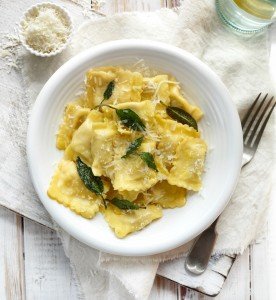 Italy has so many pasta shapes and types of filled pasta it’s almost impossible to name them all. At The International Kitchen we love pretty much all types of pasta and have had the chance to make them from scratch many times during our cooking classes in Italy. Did you know that each region of Italy has its own distinctive types of pasta and dishes? And yet there are also classic-filled pasta shapes that you’ll find throughout Italy.
Italy has so many pasta shapes and types of filled pasta it’s almost impossible to name them all. At The International Kitchen we love pretty much all types of pasta and have had the chance to make them from scratch many times during our cooking classes in Italy. Did you know that each region of Italy has its own distinctive types of pasta and dishes? And yet there are also classic-filled pasta shapes that you’ll find throughout Italy.
 Sometimes it can be hard to distinguish one stuffed pasta shape from another. Making matters more complicated is that often times the words “ravioli” and “tortelli” are used as generic terms to describe any type of stuffed pasta. So what is the difference between the filled pasta called “ravioli” and those called “agnolotti” for instance? Between tortellini and cappelletti?
Sometimes it can be hard to distinguish one stuffed pasta shape from another. Making matters more complicated is that often times the words “ravioli” and “tortelli” are used as generic terms to describe any type of stuffed pasta. So what is the difference between the filled pasta called “ravioli” and those called “agnolotti” for instance? Between tortellini and cappelletti?
Here is a brief primer focussing on types of pasta to help you out.
(Or skip to a list of stuffed pasta recipes from our archives.)
Life is a combination of magic and pasta.
– Federico Fellini
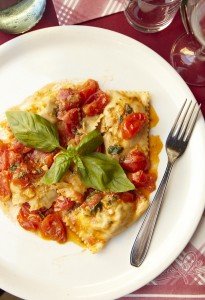 Ravioli
RavioliThis is the most well-known stuffed pasta. The singular form is “raviolo” and they are usually made by putting the filling between two sheets of pasta (versus using one piece of pasta and folding it over). The most traditional filling is cheese-based, and it varies in its specifics from region to region. They can be round or square, or (more rarely) a “mezzaluna” shape. Although you can find them in all regions, we love the ravioli Chef Matia makes at our Antinori’s Noble Tuscany cooking vacation!
An agnolotto (this is the singular form) is a type of raviolo. However, it is made from a single piece of pasta folded over and sealed to form a rectangle. The filling is usually meat and vegetable-based, rather than cheese-based. You will also see them called agnolotti del plin: the word “plin” in the area of Piedmont from which agnolotti come means “pinched,” as in what you do to the dough when you fold it over to seal it.
 Cappelletti
CappellettiThe word “cappelletti” literally means “little hats,” and refers to their shape, which resembles a hat. They are formed from one piece of dough, filled, folded over, and the ends pinched together. They can be found stuffed with a meat or (less commonly) a cheese filling. One traditional (and delicious) way of serving them is in broth. You can try your hand at it during our Flavors of the Real Italian Countryside cooking vacation, where they also prepare an excellent parmigiano cheese that pairs perfectly.
An interesting side note? The shape of cappelletti is the same as that of another type of stuffed pasta, cappellacci, but these last are larger and frequently don’t contain meat in the filling.
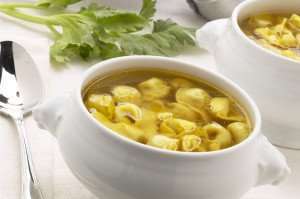 Tortellini
TortelliniVery much like cappelletti, tortellini are distinguishable by their shape (a “ring” shape in this case, said to resemble the belly button of the goddess Venus!) and can be filled with meat or cheese. They tend to be on the smaller side (and if they are larger are called “tortelli,” which is also used as a generic term for filled pastas, or “tortelloni,” as below). One classic preparation is “in brodo,” or served in a rich meat broth, which you can try during our Living the Real Tuscan Dream culinary vacation. Another is with a traditional Bolognese meat sauce.
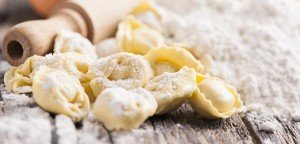 Tortelloni
TortelloniThese are basically large tortellini (“-one/-oni” is an aggrandizing suffix in Italian). The fillings can vary, but they are less often filled with meat and more often with cheese and vegetables such as spinach or mushroom. They are not often served in broth, but usually with a tomato-based meat sauce or a butter and sage sauce.
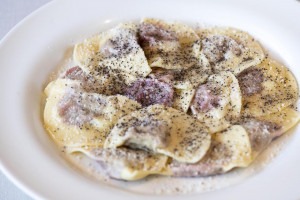 Casunziei
CasunzieiCasunziei ampezzani is a unique filled pasta originally from the town of Cortina d’Ampezzo in the northern Veneto region, in the area of the Dolomite Mountains. They are made in a half-moon shape with a very thinly rolled dough, and the filling is based on local seasonal produce, which means the recipes can vary greatly. The classic ricetta casunziei (casunziei recipe) calls for a filling made with beetroot or red turnip, creating a highly colorful dish. A lesser-known variety employs fresh herbs and spinach, resulting in a vibrant green filling. A casunziei ricetta will usually call for the pasta to be dressed with a butter and parmesan sauce that includes a surprise ingredient: poppy seeds!
See a recipe for Casunziei.
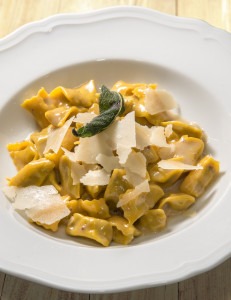 Stuffed Pasta Recipes from our Travels in Italy
Stuffed Pasta Recipes from our Travels in ItalyIf you’re looking to make some wonderful stuffed pasta recipes at home, check out these favorites:
Have you made homemade stuffed pasta? What shape did you choose? What did you fill it with? Remember, you can learn to make them in Italy during one of our cooking vacations or one-day classes.
By Peg Kern
Find more photos, food facts, and travel stories from The International Kitchen on Facebook, Instagram, YouTube, Pinterest, and Twitter.